|
Departments
eBook now Available!
|
Exclusive - THE book on Traditional & Classic
Siamese cats
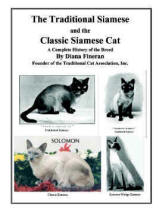
Written by the Founder of TCA, Inc.
Tullycrine
Affordable
Web Design
|
|
|
The Traditional Maine Coon FAQs
©
June 2000
Traditional Maine Coon Breeders
Diana Fineran
|

GR.CH Pedropurrs Alexander the Great |
Pictures Courtesy of
Helen Johns
Click on small Pictures
to Enlarge |

GR.CH Pedropurrs Top Cat |
Q: What is the History of the Maine Coon?
A: The Maine Coon Cat is our native American longhaired breed of large size.
Some can weigh upwards of 30 pounds. It is a mixture of elegance and ruggedness,
a wild look yet gentleness personified.
First mention of the Maine Coon is made in Francis Simpson's, "The Book
of the Cat" in 1902. In fact a whole section is dedicated to this very old
breed, written by F.R. Pierce. Here he asserts, "From my earliest
recollection I have had from one to several long-haired cats of that variety
often called Maine cats. As to how and when they came, I would say, like Topsy,
they just "growed", for their advent reaches far back beyond the
memory of the oldest inhabitant. As early as 1861 my younger brother and myself
owned jointly a beautiful long-haired black, pointed with white; be bore up for
several years under the remarkable name of "Captain Jenks of the Horse
Marines". I have no recollection of his earlier history or advent. I fancy,
however, that these cats came into Maine much in the same way and about the same
time that they did in England."
"The Maine people having had them so long, it is difficult to arouse any
great enthusiasm about them there. They are much like other people, they go into
heroics over things they know less about."
"Not until the craze for long-haired cats struck the West did they think
much about selling cats. Their very best would be given to their dearest
friends. When I think of the number of beauties that I have had given me on my
return visits because I would be good to them, it makes me wish for the good old
times when the little dear were beyond price in "filthy lucre".
"I have a photograph of "Richelieu", owned by Mr. Robinson, of
Bangor, Maine, who had won first in his class at Boston, New York and
Philadelphia previous to 1884, when he was shown at Bangor, Maine, in a limited
show of the one hundred best cats. He was a silver or bluish tabby, very lightly
marked, about seven years old at the time, weight about twenty pounds. He was,
as his picture shows, rather a coarse-grained variety, a drug store cat. I know
nothing of his early history, but his owner had the cat fad, a well developed
case, and traveled from city to city to show his cat, much as we are all doing
now twenty years later.
"At that time Maine, near the coast, was rich in fine specimens of the
long haired cats. That was before they began to sell. I have in mind their brown
tabbies."
"We often hear it said by people who know them not that the Maine cats
are unhealthy, but that they have worms. And I have to admit it, and that they
sometimes die like other cats. But here is one that didn't until he had rounded
out his full seventeen years. Leo is a brown tabby, born 1884, died 1901,
presented to Mrs. Persis Bodwell Martin, of Augusta, Maine, by Mrs. E. R.
Pierce, when he was six months old. He lived a life of luxury and ease, having
his meals served by his mistress's own hand in the upper hall, where he chose to
spend his time for the later years of his life. His hair was so extremely long
his tabby marking became somewhat confused. "
"They had some extremely fine brown tabbies in Maine. In the summer of
1900 I bought "Maxine" there...the mother of "Young Hamlet",
who won over his sire "Prince Rupert" the first year he was shown. She
was, or is, very much the type of the "King Humbert" stock, though she
has not pedigree whatever."
"It is one of Nature's own secrets how they keep bringing forth..now and
then, not always, these fine types."
"I have before me a most interesting letter from a Maine Lady, one of my
contemporaries."
"I will first explain that Maine at that time was one of the largest
ship building States in the Union, residents of the seaport towns and cities
being often master of their own floating palaces, taking their families with
them to foreign countries, and having in many towns quite social sets, like the
army set or official set in other sections."
"Mrs. Thomas, to whose letter I refer, was the daughter of the late
Captain Stackpole, who commanded his own ship for many years, taking his wife
and little daughter with him. That was before our Civil War. She says, "I
was always very fond of cats before they had to have a pedigree." In
writing of her own cat the mother of "Swampscott she says, "I cannot
tell you much about my cat's pedigree...only that her great grandfather was
brought to Rockport, Maine form France. He was a blue eyed white." She then
describes acquiring a Persian from France, and a Manx from the Isle of Man, who
went aboard ship until they arrived back home to Maine. "This is proof how
different varieties of cats got root in Maine. Pets of every variety were bought
in foreign ports to amuse the children on shipboard and found their way to
nearly all the coast towns...many more in the past than at this time. When
sailing vessels have passed their usefulness as money making institutions, and
those that do go out are not commanded by their owners...paid captains as a
rule, cannot take their families with them, and the supply of cats from that
source has been cut off for many years, so those we find there now can safely be
called natives."
"I really know nothing of the cats that are said to be found on the
islands, but no doubt they are much the same as those found all along the New
England coast."
"For a long time the long haired cats seemed to be confined mostly to
the coast towns and cities, but the giving their best to "their sisters and
their cousins and their aunts" have spread them inland, as well as
scattered them over nearly every State in the Union. They thrive as well as any
other long haired cat. No doubt they do still better in Maine, but the
difference comes from the fact that they have the freedom of living a natural
life, without dopes or over coddling. Their offspring are beautiful, because
they are form their own choosing, and not from compulsory mating, often
distasteful, no doubt."
"A few people who had never seen a cat show in their native land
"go across" (the Atlantic), attend a cat show, or pick up a cat at a
bargain on the streets of London. The "fetch" it home, and lo! Their
neighbor has seen something very like it while at their summer home on the coast
of Maine."
"In the meantime, the demand for the home grown article is increasing,
and prices are getting much inflated. The dealers in large cities keep their
buyers busy in the New England field during the fall and winter months. But the
stock of kittens has been looked over by the summer residents or visitors. The
real cream disappeared with the first frost to some winter homes in the big
cities. The dealers get what is left at almost any price they please to pay,
many of the specimens being indifferent, and some, no doubt, mongrels."
"In the last few years I have known less of the Maine cats, except
through the shows and a few that I have owned myself, which have not been shown
much or proved remarkable in any way. But among the gems that have shown out
with more or less brilliance when on the bench we find "Cosie" (also
spelled "Cosey"), a brown tabby, taking first and special for best cat
in show in New Yorks Madison Square Garden, 1895. Cosie was owned by Mrs. E.N.
Baker and bred by R.R. Pierce. Mrs. Lambert brings out "Patrique" in
New York in 1896...blue, and a nice one."
"King Max", bred by F.R. Pierce, first brought out by Mrs. Taylor,
won the Boston first in 1897-1898-1899, only to be beaten by his sire
"Donald" in 1900."
"Mrs. Mix has shown a fine Persian type from Maine called the 'Dairy
Maid". I believe she has also "Imogene", from the same place...a
tortoiseshell."
"Mrs. Julius Copperberg's, "Petronius", of whom we all
expected great things, was from a line of creams coming well down from a fine
cream brought from some Mediterranean port by one Captain Condon about fifteen
years ago. I have secured for friends several kittens from his cat's
descendants, which are now somewhat scattered, but all showing great strength,
form, bone, and sinew."
'Mrs. Chapman's, "Cusie Maxine", a fine type of brown tabby, dam of
"Young Hamlet", who won over his sire, "Prince Rupert", was
also a Maine Cat."
"Mr. Jones, of "The Cat Journal" has from time to time had
some fine brown tabbies of the Maine stock, winners at some of the larger
shows."
A fair representative of the whites, who has acquitted himself well at the
various shows in competition with large classes, is, "Swampscott",
owned by Mrs. F.E. Smith, of Chicago. He comes from Mrs. Georgia Thomas's white
cats at Camden, Maine, his maternal great, grandsire coming from France."
"Midnight", a younger black cat, winning second at Cincinnati to a
cat from New Hampshire in better coat, and second in Chicago in 1901 in large
classes, has since become a gelding and pet of Mrs. J.J. Hooker of Cincinnati.
He comes from a line of black owned by a retired sea captian named, Ryan, who
had at one time four generations of black cats. They loved their cats like
babies, and for years looked for people "suitable" to give their
kittens to. I have been the flattered recipient three times in the last dozen
years of these beautiful black diamonds."
"Antonio", a gelding, now owned by Mrs. A.B. Thrasher, of
Cincinnati, Ohio, is also a fine representative of this. In the last few years,
since cats there are at cush a premium and old age getting nearer every day,
these good people have hardened their hearts, and now sell like others to the
highest bidder."
"I can also think of "Peter the Great", a neuter cream and
white, owned by Mrs. Carl Schmidt, shown at Detroit, Michigan, 1901. Also
"Black Patti", originally owned by Miss Ives, and "Rufus",
both Maine cats, now owned in Detroit, and winners in some of the Middle West
shows. And many, many other winners whose place of nativity is a sacred secret
with their owners, which we will not willfully expose to public gaze until our
native cats have been accorded the place that is due to them."
"I would like to tell you of some of the handsome geldings in Maine. No
cat is too good for a pet with them. They may be seen on nearly every lawn or
stoop, but as that is a little out of the province of this story I will only
describe one...a beautiful smoke owned by Dr. And Mrs. E.A. Wilson at their
beautiful home in Belfast, Maine. He is now ten years old. His mask and feet are
black, or nearly so. His hair is very dark, rather brownish at the tip, but as
white as snow at the skin. I have begged them to show him at Boston or New York.
The answer is always the same, "Not for any amount of money or prizes.
"Tags" wouldn't like it. He would be unhappy. Wouldn't you, "Tagsie"?"
"The smokes have not been well developed there yet. In a letter lately
received in regard to that variety, I am told that one of the regular agents
said that he found only about one in 200. The silvers and chinchillas are not
common. The strong colors predominate, white, black, blues, orange, and creams,
tabbies also being well divided and distributed along the coast, and for quite a
distance back, perhaps sixty miles or more. But I have not known of their
appearing to any extent in the northern portion of the State, which is less
thickly settled."
:Having had this fancy from my infancy and before it became a fashion, I took
kindly to all the new developments. I have since had some experience with
imported and kennel bred cats, and from time to time had opportunities of seeing
the best we have in our shows, and I fully believe that cats that have their
freedom, as most of the Maine cats have for the greater part of their lives, are
healthier than kennel cats can be. The cool climate and long winters, with clean
air full of ozone, is what is needed to develop their best qualities, and, with
a few year of careful breeding for types, they would be able to compete quite
successfully in an international cat show." This is the conclusion of the
Maine Coon section in Francis Simpson's book. Hints are given of Persians or
possibly Turkish Angoras crossing the Atlantic with Sea Captions to the North
East Coast of the U.S., but the true origins of the breed are obscure and the
subject of legend.
Q: What are some of the Legends and Myths about these cats?
A: Dubbed the "Gentle Giants" of the cat kingdom, it is a puzzle
why some people once believed the Maine Coon was the result of breeding American
Bobcats with the domestic cats brought to the Northeastern seaboard. Perhaps the
long hair and the tufted ears, similar to the bobcat's, caused this legend.
Another myth is that raccoons bred with domestic cats, since the bushy, ringed
tail of the brown tabby. Both of these are impossible to have happened because
neither Bobcats or raccoons can interbreed with domestic cats.
An additional account exerts that the ancestors of the Main Coon were rooted
in Norwegian Skogkatts brought here by Vikings.
Even more imaginative of the lore handed down over the decades is the tale
involving a Captain Samuel Clough and Marie Antoinette. As the story goes
Captain Clough was a major player in a plan to secretly remove the French Queen
from France to Wiscasset, Maine. Captain Clough loaded aboard his ship, the
Sally, some of the Queen's personal, luxurious and priceless possessions,
including six of her favorite pet cats. A sudden outburst of violence resulted
in the seizure and eventual beheading of Queen Marie Antoinette! Like any other
principal who's benefactor just lost her head, Captain Clough quickly boarded
his ship and set sail with all haste to escape any repercussions for his part in
the attempted rescue. With him went the Queen's personal property and six long
haired cats still on board. This story assumes the Queen's cats bred with the
local American cats to create the Maine Coon.
Another twist of this story is one that is based on this narrative. Queen
Marie Antoinette's Angora Cats were gifts to the Marquis de Lafayette from the
Queen on one of his trips to the New World during the American War of
Independence (1775-1783. Once here the Queen's Angoras mated with local cats.
Still one more legend expounds about an English sea captain, who was to have
the most unlikely name of "Coon". His fondness of cats enabled him to
sail up and down the New England coast taking his cats with him on board. With
him were the Persians and angoras popular in England. Each time the Captain went
ashore his cats went with him. Soon long haired litters began appearing in local
litters, so the owners called them, "One of Coon's cats." Whether or
not these whimsical, yet charming stories is true is entirely lost in the mists
of time.
More believable is the inevitable consequence of the mixture of the cats
brought with the original settlers in about 1640 with long haired Angora or
Persian cats who came later aboard sailing ships. Sea voyages in the 1600's were
long and dangerous, and rat were stowaways. Cats were brought along to protect
the food on board. Many female cats became pregnant on these voyages and
delivered their kittens at sea. Upon arrival in the upper North East, many of
the kittens boan on board would be put ashore to find their way in the New
World. The harshness of the New England winters played a part in forming the
survivors of this process. They were free roaming in the rugged Maine country
for years, developing the rugged coats and constitution able to withstand of the
climate. It was in the 1860's that farmers extended their bragging about their
intelligent, beloved mousers into their own Maine Coon show at the Skowhegan
Fair, where their cats competed for the title "Maine State Champion Coon
Cat". Discontinued in the 1960's, this cat show was the arena in which the
breed was given its early recognition. Thus the Maine Coon was chosen as the
best Cat at the first major cat show ever held in the U.S.
Founded in 1908, CFA began Registering "Maine Cats", which required
a signed statement saying the sire and dam were "of the same breed, long
hair and that neither is a shorthaired". Cat #5 in the CFA Registry is a
tortoiseshell female Maine Cat named Molly Bond. The first volume of CFA's
Registry included twenty-eight cats identified as Maine Coons.
Once Persians came to the fore front of the cat show scene, the Maine Coon
diminished in popularity. The last big victory for the Maine Coon came in 1911
at the Portland, Oregon show. Out of 170 cats entered a "longhaired, blue
Maine Cat" received first place in his class and best of show.
Then they went into the shadows for decades beginning in 1904, and were
declared "extinct" in the late 1950's. That, of course, was not true.
Early in the 1950's clubs once again began to force notice of the Maine Coon
until they were once again in the winners circle at major cat shows across the
country. The first Breed Standard for the breed was written in 1967.
The Maine Coon was named the official Maine State cat in 1985 by the then
Governor.
Q: What type of personality do they have ?
A: The Maine Coon is a vocal breed, which talks with an endearing
variety of meows, chirps or thrills. Extremely loyal, gentle, with a loving
nature, great intelligence, a kindly disposition, a sweet temperament and
sociable, they get along with children and dogs, making a wonderful family pet.
They are alert and very friendly. They enjoy helping and being involved with any
project going on in the household. They love to sleep in strange and awkward
places and positions. They use their paws to do tricks and to play with water,
which they will cup in their paws or cause to swirl in their water dish so they
can watch it move. Their front feet are also used to pick at food, taking a
small piece and dropping it on the floor to eat. There is a look in their eyes
that says they like people and love fun. These are mellow cats, amiable and easy
to get along with when they know you. Following "their person" from
room to room, quietly co-existing is a definite plus for this breed. They are
not overly dependent and do not constantly pester their owners for attention.
Maine Coons will drape their tails over and across a variety of items, including
their humans' faces. These cats also enjoy butting heads with their humans. Both
genders are dignified in carriage and are adept at avoiding vases, figurines and
plants... a real blessing considering their size. For all around adaptability,
personality and ease of grooming, plus tops in amusement and affection, the
Maine Coon is a perfect pet. Owners say they are perpetual kittens, playing well
into their old age. In the show ring it is a unique stand out, not only for its
type but also in color and color pattern, all making for a cat that reflects its
natural heritage.
Historical Record © March
2002
Diana Fineran
|
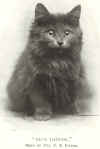
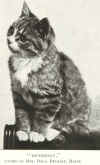
|
Click on picture to enlarge |


|
These 1902 photos of Traditional Maine Coons are of great interest, because
they present the breed as it originally became known, and as TCA, INC.
recognizes them now.
The TRADITIONAL MAINE COON (MC) (c)
Copyright, Diana Fineran, June 12, 2000
|
|
|
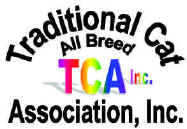
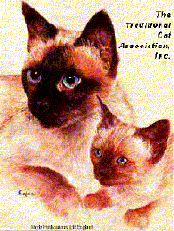 The
Traditional Cat Association,
Inc.©1987®TM
Official Website
The
Traditional Cat Association,
Inc.©1987®TM
Official Website




